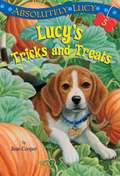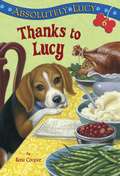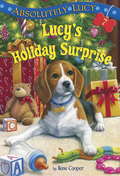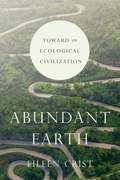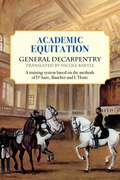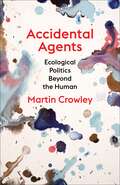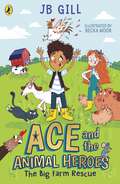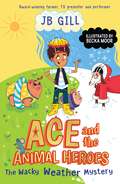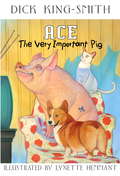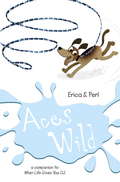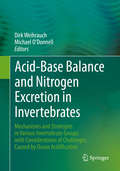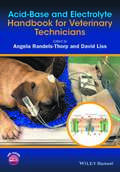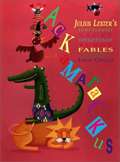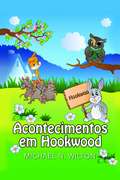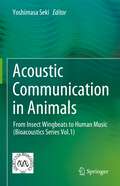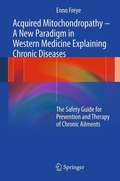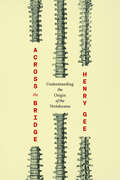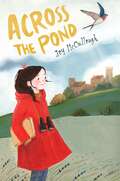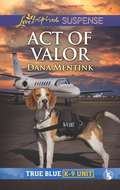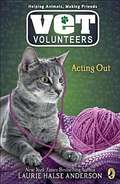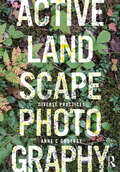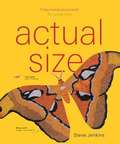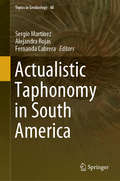- Table View
- List View
Absolutely Lucy #5: Lucy's Tricks and Treats (Lucy #5)
by Ilene Cooper David MerrellIlene Cooper's fifth story of a boy and his beagle follows Bobby and Lucy as they roll with the tricks and treats of Halloween.Tricks and treats-that's what Halloween is all about. This year, Bobby has lots of both! He has a special treat planned with his beagle puppy, Lucy. And the tricks? Bobby is getting those at school with the new kid, Jack. Bobby can't figure Jack out. And ever since Jack arrived, things have gone missing around the classroom. Halloween has never been so mysterious!From the Trade Paperback edition.
Absolutely Lucy #6: Thanks to Lucy (Lucy #6)
by Ilene Cooper David MerrellIlene Cooper's sixth story of a boy and his beagle follows Bobby and Lucy as they celebrate the Thanksgiving holiday in their own doggy way. Bobby has a lot to be thankful for this Thanksgiving. He might soon become a big brother, his grandmother is coming for a visit, and he's absolutely thankful for his mom's pies, especially the pumpkin ones. But the number-one thing Bobby wants to give thanks for? His dog, Lucy. Lately, though, Lucy hasn't been her usual frisky self. She's quiet. She seems unhappy. Is something wrong with Lucy?
Absolutely Lucy #7: Lucy's Holiday Surprise
by Ilene Cooper Royce FitzgeraldAdopted twin girls, a precocious pup, and a busy holiday season make Christmas at the Quinns' house a bit crazy! Bobby is excited to have two adopted baby sisters, but he's also excited for Christmas. While his parents take care of the babies, Bobby and his beagle, Lucy, play in the snow and even build a snow beagle! But as Christmas gets closer, Bobby starts to worry. His parents haven't had time to decorate the house, or get a tree, or bake cookies. Will the Quinn family be able to get ready for Christmas before it's too late? With a little help from friends, family, and one special beagle, they just might! Fans of Puppy Place and Magic Puppy will love this sweet holiday story in the Absolutely Lucy series.
Abundant Earth: Toward an Ecological Civilization
by Eileen CristIn Abundant Earth, Eileen Crist not only documents the rising tide of biodiversity loss, but also lays out the drivers of this wholesale destruction and how we can push past them. Looking beyond the familiar litany of causes—a large and growing human population, rising livestock numbers, expanding economies and international trade, and spreading infrastructures and incursions upon wildlands—she asks the key question: if we know human expansionism is to blame for this ecological crisis, why are we not taking the needed steps to halt our expansionism? Crist argues that to do so would require a two-pronged approach. Scaling down calls upon us to lower the global human population while working within a human-rights framework, to deindustrialize food production, and to localize economies and contract global trade. Pulling back calls upon us to free, restore, reconnect, and rewild vast terrestrial and marine ecosystems. However, the pervasive worldview of human supremacy—the conviction that humans are superior to all other life-forms and entitled to use these life-forms and their habitats—normalizes and promotes humanity’s ongoing expansion, undermining our ability to enact these linked strategies and preempt the mounting suffering and dislocation of both humans and nonhumans.Abundant Earth urges us to confront the reality that humanity will not advance by entrenching its domination over the biosphere. On the contrary, we will stagnate in the identity of nature-colonizer and decline into conflict as we vie for natural resources. Instead, we must chart another course, choosing to live in fellowship within the vibrant ecologies of our wild and domestic cohorts, and enfolding human inhabitation within the rich expanse of a biodiverse, living planet.
Academic Equitation
by General DecarpentryOriginally written and published in 1949,Academic Equitationwas considered by dressage experts to be the most important contribution to classical training in the twentieth century. This book was intended as a preparation for international dressage competitions but is far more than this. It discusses the subjects of academic equitation, the riding master and the choice of horse before introducing the reader to the author's systematic program, covering the very early training right up to the most advanced movements.The appendix deals with lungeing, work in hand, long reins and pillar work. General Decarpentry was not only a distinguished scholar of artistic equitation but also equally versed in putting the theories into practice. He deals with the education of the young horse and the complications and details of advanced schooling with the hand of a master.Although he claims that nothing in the book is his—his training system is based on the methods of D'Aure, Baucher and L'Hotte—the General's wisdom and deep knowledge are manifest throughout. It was the General's great wish that traditional teachings on the art of equitation should not be lost to those who wished to study equitation. In this most important work he has succeeded in presenting these teachings in such a way that allows both layman and expert to obtain a deeper insight into this fascinating subject.
Accident!
by Andrea TsurumiWhen a clumsy armadillo named Lola knocks over a glass pitcher, she sets off a silly chain of events, encountering chaos wherever she goes. But accidents happen—just ask the stoat snarled in spaghetti, the airborne sheep, and the bull who has broken a whole shop’s worth of china. In the tradition of beloved books like The Dot and Beautiful Oops, this charming, hilarious debut from author-illustrator Andrea Tsurumi shows that mistakes don’t have to be the end of the world.
Accidental Agents: Ecological Politics Beyond the Human (Insurrections: Critical Studies in Religion, Politics, and Culture)
by Martin CrowleyIn the Anthropocene, the fact that human activity is enmeshed with the existence and actions of every kind of other being is inescapable. As a result, the planetary ecological crisis has brought forth an urgent need to rethink understandings of human action. One response holds that the transformations necessary to tackle today’s crises will emerge from the distinctive capacity of human beings to transcend their environment. Another school of thought calls for seeing action as composite, produced by distributed networks of human and nonhuman agents. Yet the first of these is open to charges of human exceptionalism, while the second, according to its critics, lacks effective political traction.Martin Crowley argues that a new conception of political agency is necessary to break this impasse. Engaging with thinkers such as Bruno Latour, Bernard Stiegler, and Catherine Malabou, Crowley proposes an original account of agency as both distributed and decisive. Challenging the prevailing view of agency as exclusively human, he explores how a politics that incorporates nonhuman agency can intervene in the real world, examining timely issues such as climate-related migration and digital-algorithmic politics. A major intervention into ongoing debates in posthumanism, political ecology, and political theory, Accidental Agents reshapes our understanding of political agency in and for a more-than-human world.
Ace and the Animal Heroes: The Big Farm Rescue
by JB GillDr Dolittle meets Dick King-Smith in this funny, charming animal adventure from pop-star, presenter and award-winning farmer JB Gill. The perfect next read for fans of Michael Morpurgo's Mudpuddle Farm and David Baddiel's Animalcolm! 'Ace couldn't believe his ears. NO WAY did a pig, two goats and a donkey just speak!'When Ace receives a surprise gift from a long-lost relative, he and his amazing grandparents pack up their life in the city and move to the countryside to live on a run-down farm.And there's an even bigger surprise in-store for Ace when he tries on some magical new wellies and realises he can talk to animals! He's going to have to master this new skill to take on the evil Councillor Crabbington, who is determined to shut down the farm!With a little help from Ginger the Pig, some squawkative hens and a new best friend, Ace must find a way to save the farm before Councillor Crabbington gets his hands on it!Full of hilarious illustrations from Becka Moor, the illustrator behind Pamela Butchart's Wigglesbottom Primary series!See what readers are saying about Ace and the Animal Heroes:'[V]ery entertaining and a pleasure to read for any young child . . . This is a fun read and comes highly recommended.' - The Independent, Children's Book of the Week'Ace and the Animal Heroes: The Big Farm Rescue is a fun and engaging book that is perfect for children who love animals and adventure. My son couldn't put it down and was captivated by the story from beginning to end.' - Amazon reviewer 'This book is so great! It is clever, funny, and the text and pictures are equally delightful. My children and I can read this over and over again without being tired of it.' - Amazon reviewer
Ace and the Animal Heroes: The Wacky Weather Mystery
by JB GillJoin Ace and the Farm Squad in their next magical adventure by award-winning farmer, TV presenter and performer JB Gill! Perfect for readers 6+ and fans of Clare Balding, Michael Morpurgo and Dick King-Smith.When Ace is wearing his magical yellow wellies, he’s able to talk to animals. So when the weather starts acting up, he knows the farm squad aren’t happy. There’s snow, hail, rain and sun – and that’s just in one day!Now Ace and his best friend Bear need to come up with a plan to solve the mystery of the wacky weather. But will they be able to fix it in time for the farm’s first festival?Beautifully illustrated by Becka Moor, The Wacky Weather Mystery is full of magic, friendship and environmental themes.About the Author:JB Gill rose to fame as a member of one of the UK's biggest boybands - JLS. He's now best known for being an award-winning farmer in the Kent countryside. Together with his family, JB presents Channel 5's Milkshake TV series Cooking With The Gills. He is also the lead presenter on CBeebies BAFTA-nominated television series Down on the Farm and features on Channel 5's On The Farm series.
Ace: The Very Important Pig
by Dick King-Smith Lynette HemmantMeet Ace, Babe's great-grandson, who also gets a new cover from Knopf Paperbacks this season. " A Horn Book Fanfare Honor Book An IRA/CBC Children's Choice A School Library Journal Best Book of the Year.
Aces Wild
by Erica S. PerlZelly Fried has finally convinced her parents to let her get a dog, with the help of her grandfather Ace. Unfortunately, said dog (also named Ace) is a shoe-chewing, mud-tracking, floor-peeing kind of dog. Despite Zelly's best efforts to drag Ace (literally!) to puppy kindergarten, his flunking report card says it all: "This Ace is wild."Also wild is the other Ace in Zelly's life. Grandpa Ace has decided to begin dating again and is dining and dancing every night, against his doctor's orders. Determined to get both Aces under control, Zelly enlists the help of her two best friends, Allison and Jeremy (despite the fact that they don't quite see eye to eye). They need to come up with a plan, fast. But how? It's not like either Ace ever does what he's told.
Acid-Base Balance and Nitrogen Excretion in Invertebrates: Mechanisms and Strategies in Various Invertebrate Groups with Considerations of Challenges Caused by Ocean Acidification
by Dirk Weihrauch Michael O’donnellThis textbook provides a comprehensive overview on the diverse strategies invertebrate animals have developed for nitrogen excretion and maintenance of acid-base balance and summarizes the most recent findings in the field, obtained by state-of-the-art methodology. A broad range of terrestrial, freshwater and marine invertebrate groups are covered, including crustaceans, cephalopods, insects and worms. In addition the impact of current and future changes in ocean acidification on marine invertebrates due to anthropogenic CO2 release will be analyzed. The book addresses graduate students and young researchers interested in general animal physiology, comparative physiology and marine/aquatic animal physiology. Also it is an essential source for researchers dealing with the effects of increasing pCO2 levels on aquatic animals, of which the vast majority are indeed invertebrates. All chapters are peer-reviewed.
Acid-Base and Electrolyte Handbook for Veterinary Technicians
by David Liss Angela Randels-ThorpAcid-Base and Electrolyte Handbook for Veterinary Technicians provides an easy to understand yet comprehensive approach to acid-base and electrolyte balance. Covers the physiology of fluids and their effect on acid-base and electrolyte balance Offers detailed information on managing acid-base and electrolyte derangements in disease Includes access to a companion website with case studies and multiple choice questions
Ackamarackus: Julius Lester's Sumptuously Silly Fantastically Funny Fables
by Julius LesterA bee who falls head-over-heels in love with a bluebird? An eagle who is afraid of heights? An alligator in search of cooler waters in Vermont? Readers of all ages will laugh at these irresistible creatures and their gleefully absurd predicaments, all the while unwittingly gathering wisdom about acceptance, ingenuity, and individuality.
Acontecimentos em Hookwood
by Michael N. WiltonQuando a vida animal em Hookwood é perturbada pela chegada dum casal novo ansioso para construir a sua primeira morada juntos numa cabana abandonada, um Coelho jovem curioso chamado Starup decide ajudar comendo o resto do almoço do piquenique, que tinha sido doado por um velho amigo para festejar a ocasião. Como castigo a mãe Dora mandou-o tomar conta da amiga distraída, a Gansa Clara, enquanto ela muda de casa de forma a que escape à atenção do animal de estimaçao do jovem casal, um gato cor de gengibre aterrarizador. Depois de restaurar as economias duma vida dos seus amigos, dubiamente conseguida pelo Esquilo Nabbit, o vil prestamista, Startup propõe-se a evitar que o ninho da Clara caía nas mãos do rato castanho de palavras mansas conhecido como Capitão Mayfair, que anda à procura de fundos para financiar a revolta liderada pelo assustador Rei Freddie e a sua colónia de ratos castanhos. Visto como uma ameaça ao sucesso dos planos do Capitão, Startup é encorajado a ser enfeitiçado pela arma secreta dos ratos castanhos, uma coelha de olhar furtivo chamada Lola, que é enviada para iludir o coelho confidante e tirá-lo do caminho. Depois de escaper várias vezes ajudado pelos amigos, Prudence e o Sábia Mocho, assim como Puggles, o porco e Hedgie o ouriço, Startup é envolvido numa batalha continua com os ratos castanhos, e rapidamente encontra-se em confront directo com o arquevilão, o próprio Rei Freddie. Num emocionante climax, Startup é apanhado numa batalha desesperada mão-a-mão para acabar com o Rei Freddie, na qual o seu amigo o Mocho Sábio vem ao seu auxílio, disposto a sacrificar a própria vida ao faze-lo.
Acoustic Communication in Animals: From Insect Wingbeats to Human Music (Bioacoustics Series Vol.1)
by Yoshimasa SekiThis book is the first volume of the bioacoustics series published by the Society for Bioacoustics. This volume provides an overview of the advances and recent topics in acoustic communication in various animals. Most animals produce vibrations and sounds by moving their body parts, including vocal organs. These sounds can be research targets of bioacoustics studies. How animals use these sounds, especially in inter-individual relationships, is the focus of this volume, “Acoustic Communication in Animals”. The authors’ expertise varies from molecular biology, neurobiology to psychology, and human brain imaging. Their research subjects range from invertebrates to humans. Despite the variety of topics, chapters are developed under the consideration of ethology and evolution. Readers will recognize the profundity of the topics in each chapter. In addition, the view and understanding of natural sound sequences produced by animals can vary among different cultures. Research from Japan and regions that have been underrepresented in previous literature can offer new ideas and unique perspectives in the study of bioacoustics. Readers can grasp the progress of this research field in a broad range of species in one book. The book presents multi- and interdisciplinary topics and appeals to researchers and students in fields including psychology, physiology, zoology, ethology, and neurosciences.
Acquired Mitochondropathy – A New Paradigm in Western Medicine explaining Chronic Diseases
by Enno FreyeThe book on Acquired Mitochondropathy offers a new perspective on the understanding and the treatment of chronic ailments. Addressing a new paradigm deemed necessary, since in one of every four adults in the western world chronic ailments are on the rise. Resulting from energy dysfunction of cellular organelles, the mitochondria, the most of the common symptoms the physician faces during medical consultation are presented. An increasing focus on chronic disabilities presents difficulties for the busy practitioner, since patients typically describe a complex pattern of discomfort, disability, and distress, with pain affecting physical, social, and psychological functioning, which have to be put in the proper perspective. Since clinicians must efficiently condense widely varied symptomatic descriptions into characteristic patterns to permit accurate diagnosis and implement effective treatment, this book serves as a useful educational resource for the healthcare provider.
Across the Bridge: Understanding the Origin of the Vertebrates
by Henry Gee“Addresses an important topic for biologists and zoologists about vertebrates’ place in the ‘grand scheme’ . . . genuinely witty and charming . . . magnificent.” —Neil J. Gostling, University of SouthamptonOur understanding of vertebrate origins and the backbone of human history evolves with each new fossil find and DNA map. Many species have now had their genomes sequenced, and molecular techniques allow genetic inspection of even non-model organisms. But as longtime Nature editor Henry Gee argues in Across the Bridge, despite these giant strides and our deepening understanding of how vertebrates fit into the tree of life, the morphological chasm between vertebrates and invertebrates remains vast and enigmatic.As Gee shows, even as scientific advances have falsified a variety of theories linking these groups, the extant relatives of vertebrates are too few for effective genetic analysis. Moreover, the more we learn about the species that do remain—from sea-squirts to starfish—the clearer it becomes that they are too far evolved along their own courses to be of much use in reconstructing what the latest invertebrate ancestors of vertebrates looked like. Fossils present yet further problems of interpretation. Tracing both the fast-changing science that has helped illuminate the intricacies of vertebrate evolution as well as the limits of that science, Across the Bridge helps us to see how far the field has come in crossing the invertebrate-to-vertebrate divide—and how far we still have to go.“A beautiful ode to some of the least appreciated animals . . . guides the reader joyfully through deuterostomes—weaving disparate elements of embryology, paleontology, and morphology into an unprecedented and accessible narrative.” —Jakob Vinther, University of Bristol
Across the Pond
by Joy McCulloughFrom the author of A Field Guide to Getting Lost comes a heartwarming story about new beginnings, burgeoning friendships, and finding your flock.Callie can&’t wait for her new life to start. After a major friendship breakup in San Diego, moving overseas to Scotland gives her the perfect chance to reinvent herself. On top of that, she&’s going to live in a real-life castle! But as romantic as life in a castle sounds, the reality is a little less comfortable: it&’s run-down, freezing, and crawling with critters. Plus, starting off on the wrong foot with the gardener&’s granddaughter doesn&’t help her nerves about making new friends. So she comes up with the perfect solution: she&’ll be homeschooled. Her parents agree, on one condition: she has to participate in a social activity. Inspired by a journal that she finds hidden in her bedroom, Callie decides to join a birding club. Sure, it sounds unusual, but at least it&’s not sports or performing. But when she clashes with the club leader, she risks losing a set of friends all over again. Will she ever be able to find her flock and make this strange new place feel like home?
Across the Stream
by Mirra GinsburgA hen and her chicks -- with the help of a duck and her ducklings -- find a way to put their bad dreams behind them!
Act of Valor: True Blue K-9 Unit (True Blue K-9 Unit #4)
by Dana MentinkShe saw something she shouldn’t have…A True Blue K-9 Unit storyWhen airline employee Violet Griffin encounters several suspicious passengers, she’s thrust into the crosshairs of a drug smuggling operation. NYPD officer Zach Jameson and his drug detection beagle, Eddie, can tell this is no small-time threat. Someone’s gunning for Violet, and after recently losing his brother, Zach refuses to lose her, too…especially now that she’s gone from friend to the woman he’s falling for.
Acting Out #14
by Laurie Halse AndersonAn all-new book in acclaimed author Laurie Halse Anderson's series for younger readers! Zoe is back in Ambler after living with her mom in Los Angeles, and she doesn't know what to feel about it. It's fun to be back with the Vet Volunteers, but Zoe misses her mom, who is filming a movie in Canada. Meanwhile, there seems to be a rash of animals being poisoned by antifreeze across the town, and Zoe fears that David's new adopted cat, Rover, might be one of them. So the gang works to raise awareness about antifreeze poisoning, and Zoe's mom has a special surprise in store for everyone.
Active Landscape Photography: Diverse Practices (Active Landscape Photography)
by Anne C GodfreyDiverse Practices, the third book in the Active Landscape Photography series, presents a set of unique photographic examples for site-specific investigations of landscape places. Contributed by authors across academia, practice and photography, each chapter serves as a rigorous discussion about photographic methods for the landscape and their underlying concepts. Chapters also serve as unique case studies about specific projects, places and landscape issues. Project sites include the Miller Garden, Olana, XX Miller Prize and the Philando Castile Peace Garden. Landscape places discussed include the archeological landscapes of North Peru, watery littoral zones, the remote White Pass in Alaska, Sau Paulo and New York City’s Chinatown. Photographic image-making approaches include the use of lidar, repeat photography, collage, mapping, remote image capture, portraiture, image mining of internet sources, visual impact assessment, cameraless photography, transect walking and interviewing. These diverse practices demonstrate how photography, when utilized through a set of specific critical methods, becomes a rich process for investigating the landscape. Exploring this concept in relationship to specific contemporary sties and landscape issues reveals the intricacy and subtlety that exists when photography is used actively. Practitioners, academics, students and researchers will be inspired by the underlying concepts of these examples and come away with a better understanding about how to create their own rigorous photographic practices.
Actual Size
by Steve JenkinsHow big is a crocodile? What about a tiger, or the world's largest spider? Can you imagine a tongue that is two feet long or an eye that's bigger than your head? Sometimes facts and figures don't tell the whole story. Sometimes you need to see things for yourself--at their actual size.
Actualistic Taphonomy in South America (Topics in Geobiology #48)
by Sergio Martínez Alejandra Rojas Fernanda CabreraHighlighting the latest research on Actualistic Taphonomy (AT), this book presents the outcomes of a meeting that took place in Montevideo, Uruguay, in October 2017. Its respective chapters offer valuable insights into South American archaeology, invertebrate and vertebrate fauna, and flora. In recent years, there has been a surge of new research on AT, as evidenced by numerous papers, talks, theses, etc. However, there are still very few AT books or even dedicated journal articles. Reflecting the discipline’s newfound maturity, this book, written by South American authors, offers a unique resource for academics and students of Paleontology, Geology, and Biology around the world.
